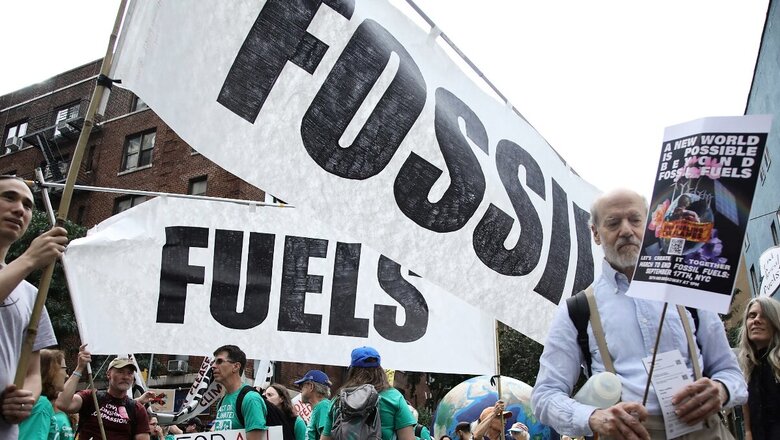
views
Germany has announced plans to store carbon dioxide at offshore sites, acknowledging that time is running out to combat climate change. Europe’s biggest economy plans to become carbon neutral by 2045.
Germany has restricted the use of carbon capture and storage (CCS), but as it is likely to miss its climate goals, Berlin has reconsidered to implement CCS, estimating the need to capture between 34 million and 73 million tons per year by 2044, as reported by news agency Reuters.
Under the new law changes, transportation of CO2 and its storage in sub-seabed areas will be allowed, with the exception of protected marine zones, Habeck added.
On-land carbon storage will remain banned unless the federal states ask Berlin to make it possible.
Last year, Denmark had launched an ambitious project that aims to bury vast amounts of carbon dioxide beneath the North Sea.
Germany economy minister Habeck said it will be “a few years” before Germany can store CO2 under the sea, as well as the Danish project.
How Will Germany Implement This?
In order to export CO2, Germany will have to sanction a clause in the London Protocol international treaty on cross-border water waste to allow transportation of carbon dioxide for storage in sub-seabed.
The plan will come into effect after the country amends the carbon storage law and create a legal framework for development of a CO2 pipeline infrastructure.
Berlin will have to sign the London Protocol amendment to make CO2 off-shore exports possible and will start exploring off-shore storage sites in Germany, the economy ministry said.
Industries such as cement and lime that cannot be electrified will benefit from this move while gas and biomass power generation plants will also be able to use technology but not at subsidised prices.
What is Carbon Storage and Removal?
Carbon storage is widely used for two sets of technology – carbon capture and carbon removal.
Carbon capture reduces the amount of carbon dioxide that goes into the atmosphere from burning fossil fuels. It is captured and put through a chemical process.
The captured carbon can be used to make products such as chemicals, fuels and cement. The benefit of it on climate will depend on how long the carbon is trapped.
Carbon removal is a technique that removes carbon dioxide from atmosphere and lock it up permanently. This includes mass planting of trees, seeding the oceans with nutrients to increase the growth of carbon-storing marine life or spreading crushed rock on land to cause chemical reactions that capture carbon from the air.
Is it Attainable?
According to a report led by the authors of the University of Oxford, carbon removal technologies may need to be scaled up by a factor of 1,300 by 2050 in order to meet Paris Climate Agreement pledge to limit temperature rise to 2°C.
The report also found that roughly 2 billion tonnes of carbon dioxide are removed globally every year, and only 0.1% comes from technologies such as direct air capture. There are 18 direct air capture plants in the world, which are running at a small scale. They remove around 10,000 tonnes of carbon a year, according to the International Energy Agency.
While the amount of carbon dioxide in the atmosphere is rising quickly, it still comprises 0.4% of air. Therefore, this makes removing carbon directly from the air more energy-intensive than removing it from smokestacks, as mentioned in a report by CNN.
What is the UN Report on Climate Change?
The United Nations’ Intergovernmental Panel on Climate Change (IPCC) said “all available studies require at least some kind of carbon dioxide removal to reach net zero”. Even if emission fall significantly, the world would need to remove at least 10-20 billion tonnes of carbon dioxide every year, according to IPCC.
The new Emissions Gas Report by the UN Environment Programme finds that there has been progress since the Paris Agreement was signed in 2015. Greenhouse gas emissions in 2030, based on policies in place, were projected to increase by 16% at the time of the agreement’s adoption. Today, the projected increase is 3%. However, predicted 2030 greenhouse gas emissions still must fall by 28 per cent for the Paris Agreement 2°C pathway and 42% for the 1.5°C pathway.
Global warming of 1.1°C above pre-industrial levels has been caused by more than a century of burning of fossil fuels, unsustainable energy and land use. This has caused extreme weather events, and danger to nature and people.
The IPCC report had said if global warming transiently exceeds 1.5°C in the coming decades or later, then many human and natural systems will face additional severe risks, compared to remaining below 1.5°C.
What is India’s Net Zero Policy?
India aims to reach net-zero goal by 2070. Its development strategy is based on: ow-carbon development of electricity systems consistent with development, ii) develop an integrated, efficient and inclusive transport system, iii) promote adaptation in urban design, energy and material efficiency in buildings, and sustainable urbanisation, iv) promoting economy-wide decoupling of growth from emissions and development of an efficient, innovative low emission industrial system, v) development of carbon dioxide removal and related engineering solutions, vi) enhancing forest and vegetation cover consistent with socioeconomic and ecological considerations and vii) economic and financial needs of low-carbon development.
The country will fix carbon emission intensity benchmarks and reduction targets for three years for companies in petrochemicals, iron and steel, cement and pulp and paper, government sources said, as quoted by Reuters.
The companies in the four sectors are also likely to be the first ones to trade on the country’s carbon trading market from April 2025, the sources added, which will enable them buy and sell carbon credits to meet their goals.



















Comments
0 comment